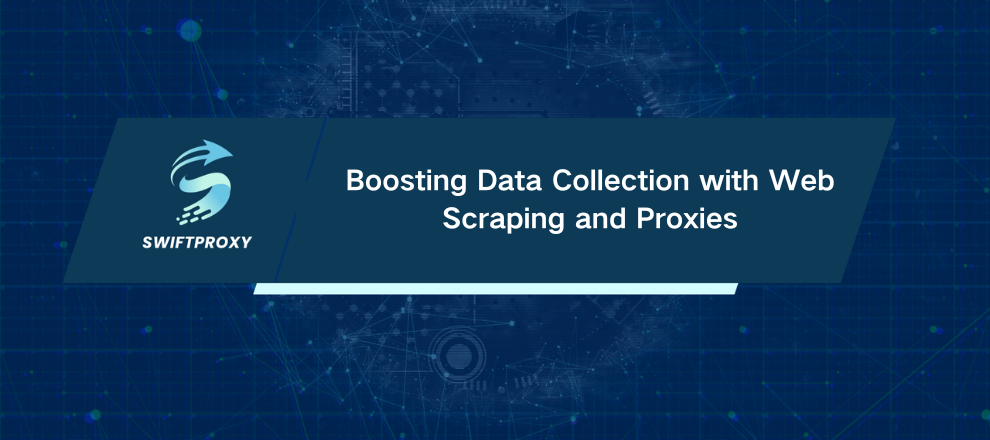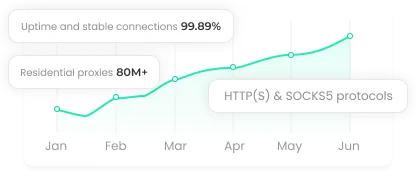Boosting Data Collection with Web Scraping and Proxies
Data is growing at an astonishing rate. Every minute, websites produce massive amounts of information, including product prices, market trends, job listings, and research papers. For businesses and researchers, being able to access and use this data is important. Web scraping offers a method to transform unstructured web content into valuable insights. In this guide, we will cover the key concepts of web scraping, explore practical tools and applications, and demonstrate how services like Swiftproxy can boost your data collection efforts.

What is Web Scraping
Web scraping is a process where you automate browsing to gather specific data. Instead of broadly indexing the web like search engines do, it converts unorganized web pages into structured formats like tables, CSVs, or databases.
Web scraping isn't just for tech geeks. It powers price comparison tools, market research dashboards, social media analytics, academic studies, and even weather monitoring. Any time you need to collect online information efficiently, scraping is your go-to technique.
In short, a program "browses" websites for you, extracts text, images, or structured info, and stores it locally. Then you can clean, analyze, and visualize the data—without touching a single web page manually.
How Web Scraping Tools Function
Web scraping tools mimic human browsing—but faster and smarter. Here's how the process unfolds:
Sending Requests
Scrapers first send HTTP or HTTPS requests to a target website—essentially asking, "Hey, give me this page."
GET requests fetch page content directly.
POST requests submit forms or queries for dynamic data.
Receiving Responses
Websites respond with HTML or JSON:
Static pages are straightforward. The data you need is right there.
Dynamic pages load content asynchronously (AJAX or APIs), which may require extra parsing or browser simulation.
Parsing Data
Parsing is the heart of scraping. HTML or JSON is messy. Scrapers use XPath, CSS selectors, or regex to extract exactly what matters: product names, prices, stock levels, and more. Accuracy here is crucial—bad parsing equals unreliable insights.
Storing Data
Once you have the data, store it where it's useful:
CSV or Excel for small-scale projects.
Databases like MySQL or MongoDB for larger, structured storage.
APIs for real-time integration into other systems.
Using Proxies and Anti-blocking
Hit the same website too often? IP blocked. That's where proxy services like Swiftproxy shine. They rotate residential IPs, simulating real users, keeping your scrapers invisible. Swiftproxy offers:
99% network stability
Global IP pool covering 195+ countries
Flexible integration for any workflow
Think of it as a stealth suit for your scraper—essential for high-volume or cross-border scraping.
Real-World Web Scraping Examples
The Economist once said, "The world's most valuable resource is no longer oil, but data." That couldn't be truer today. Properly scraped and cleaned data drives smarter business decisions, AI model training, and competitive research.
Some real-world applications:
E-commerce: Track product prices and stock across competitors.
Job boards: Extract job postings to analyze industry trends.
Social media: Collect public posts and comments for sentiment analysis.
Academic research: Download abstracts or experimental datasets efficiently.
What Web Crawlers Do
Beyond simple data collection, crawlers can power practical tools:
Automated price comparison: Aggregate prices across Amazon, eBay, Walmart—visualize trends.
Flight monitoring: Track airline tickets, discounts, and seat availability automatically.
Financial analysis: Scrape stock prices, earnings reports, and dividends for timely investment insights.
Common Types of Web Crawlers
Not all crawlers are the same:
General crawlers: Large-scale search engine bots (Google, Bing).
Focused crawlers: Target specific websites or topics.
Incremental crawlers: Revisit pages for updates.
Deep crawlers: Handle dynamic, JavaScript-heavy websites.
Distinguishing Legitimate vs Malicious Bots
Legitimate bots
Follow robots.txt rules
Access pages at reasonable intervals
Serve a valid purpose
Malicious bots
Ignore website rules
Overload servers
Pose security or financial risks
For site owners, the trick is allowing legitimate crawlers while stopping harmful ones using rate limiting, CAPTCHAs, or IP restrictions.
How to Stop Malicious Scraping
Rate limiting: Cap requests per IP or account
CAPTCHAs: Differentiate humans from scripts
Traffic monitoring: Detect abnormal patterns
Proxies and anti-scraping tools: Mask server addresses and reduce risk
Swiftproxy and Its Role in Web Scraping
By far, the hardest part of scraping isn't writing code—it's bypassing anti-scraping measures. Enter Swiftproxy. Its residential IPs make your scrapers appear like ordinary users. Advantages include:
Coverage in 195+ countries
Over 80 million residential IPs
Smooth operation for large-scale scraping
Versatile applications from e-commerce to social media monitoring
Swiftproxy doesn't just help you scrape—it helps you scrape smarter.
Conclusion
Web scraping is more than a technical trick—it's a strategic tool. Used correctly, it unlocks valuable data across e-commerce, finance, research, and more. Combine smart scraping practices with robust proxy services like Swiftproxy, and you'll turn raw web data into actionable insights, efficiently and safely.

















































